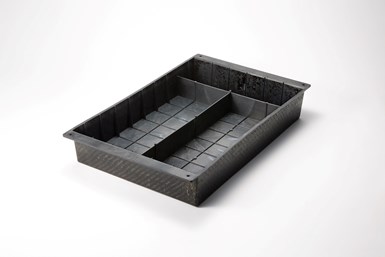Asahi Kasei presents circular composite solutions for EV batteries
Novel thermoplastic composite materials, a bio-based and biodegradable nanofiber and a technology that chemically recycles PA66 polymers enable more circular, lightweight and connective EVs.
Share
Japanese technology company Asahi Kasei (Tokyo) presents its range of diversified material solutions for safe and compact electric vehicle (EV) batteries, improved connectivity and lightweighting, as well as a circular economy.
The company is currently developing a new continuous glass fiber-reinforced thermoplastic, Lencen, formed by stacking layers of continuous glass fiber textiles with polyamide 66 (PA66) films. Due to its tensile strength, high heat resistance and impact properties similar to metal, the company says its use improves collision safety and weight reduction of EV batteries. A carbon fiber-reinforced thermoplastic (CFRTP) unidirectional (UD) tape uses recycled continuous carbon fiber and the company’s Leona polyamide resin. With a strength higher than that of metal this material can be applied to automobile frames and bodies, further enabling the recycling of end-of-vehicle-life parts into different, new automobile parts.
Asahi Kasei also highlights a bio-based and biodegradable cellulose nanofiber (CNF). This material is made from cotton linter and features a high heat resistance and network-forming ability. CNF-reinforced polyamide shows a thixotropic behavior, making it highly suitable for 3D printing applications in terms of easy printing, dimensional accuracy, smooth appearance and mechanical performance. Furthermore, CNF is reported to have better material recyclability compared to glass fibers.
The company also presents comprehensive solutions for establishing a sustainable lifecycle for PA66 using bio-based feedstock and a new technology for chemical recycling. Together, with Japanese partner company Microwave Chemical, the company is working on a new technology for chemical recycling of PA66. The process uses microwaves to depolymerize automotive airbags and other PA66 parts and directly obtain the monomers hexamethylenediamine (HMD) and adipic acid (ADA), which is expected to be accomplished at high yield with low energy consumption. The monomers obtained can then be used to manufacture new PA66. It will also eventually be used to recycle polymers with fiber reinforcement.
Related Content
-
Evolving natural fiber technology to meet industry sustainability needs
From flax fiber composite boats to RV exterior panels to a circularity model with partnerships in various end markets, Greenboats strives toward its biomaterials and sustainable composites vision in an ever-changing market.
-
Natural fiber composites: Growing to fit sustainability needs
Led by global and industry-wide sustainability goals, commercial interest in flax and hemp fiber-reinforced composites grows into higher-performance, higher-volume applications.
-
BiDebA project supports bio-based adhesives development for composites
Five European project partners are to engineer novel bio-based adhesives, derived from renewable resources, to facilitate composites debonding, circularity in transportation markets.


